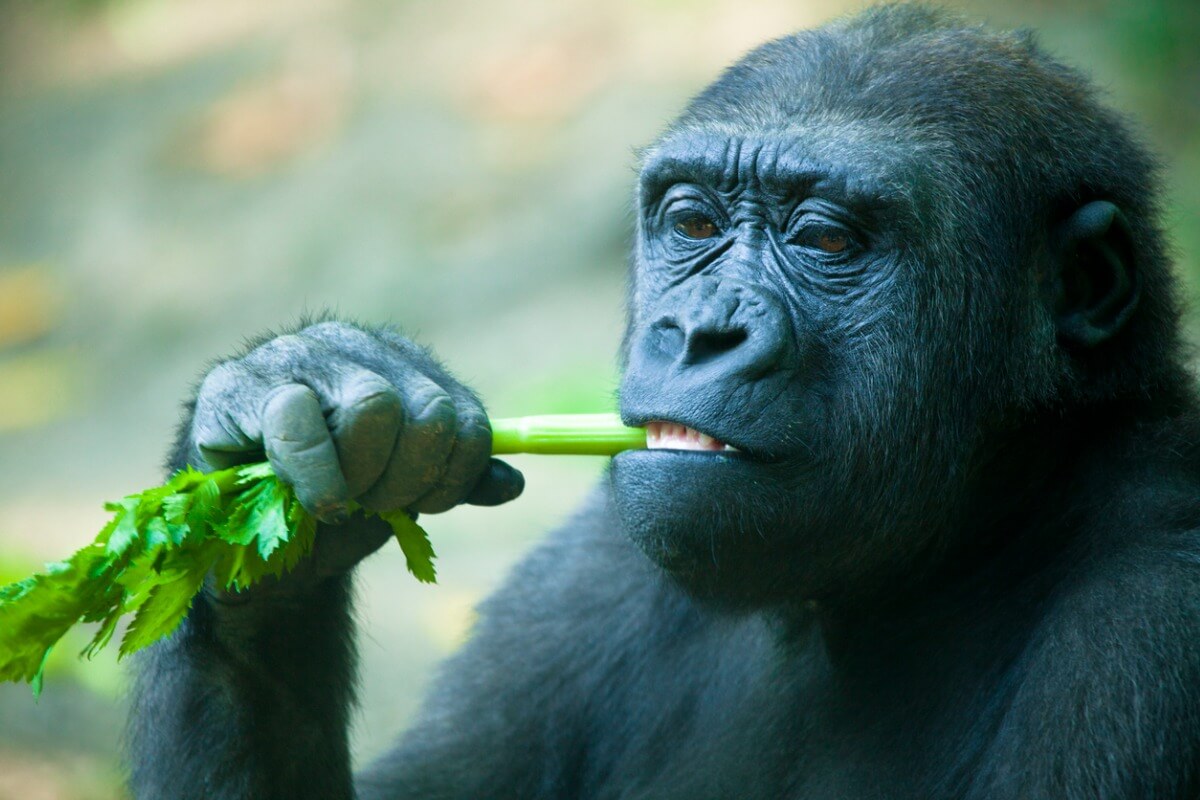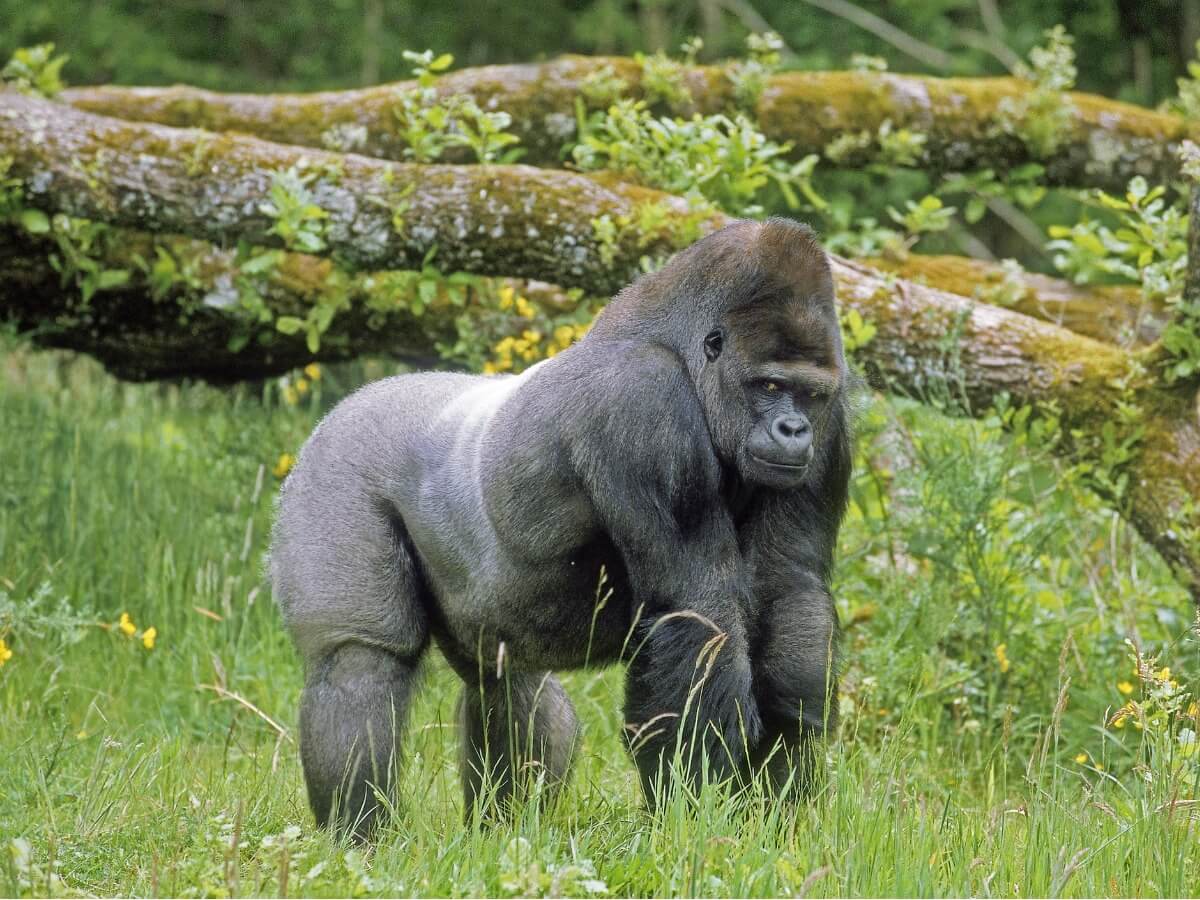What Do Gorillas Eat?


Reviewed and approved by the biologist Samuel Sanchez
The genus of gorillas (the largest primates) is composed of two species, each with two other accessory subspecies. It can be seen at a glance that their similarity with humans is very great and their DNA is 97-98% similar to humans (although it should also be said that mice are 97.5% similar!) With this data, it’s quite normal to ask how similar gorilla food is to our own. We’ll be looking at what gorillas eat in this article.
These anthropoids are considered very intelligent animals, as some have even learned basic words in sign language in captivity. They are currently endangered and therefore need to be protected and observed. Discover what gorillas eat…
General characteristics
Did you know that all gorillas share the same blood type and that, like humans, each gorilla has unique fingerprints that identify it? The physiological traits of primates are fascinating and leave no one indifferent.
Until recently, only a single species of gorilla was considered, with three subspecies: the western, the eastern, and the mountain gorilla. Now, however, the following two species are considered, each with two subspecies, which live in the tropical and subtropical forests of Africa:
- Western gorilla (Gorilla gorilla): This has the subspecies western lowland gorilla (Gorilla gorilla gorilla) and Cross River gorilla (Gorilla gorilla diehli).
- Eastern gorilla (Gorilla beringei): This includes the subspecies mountain gorilla (Gorilla beringei beringei) and eastern lowland gorilla (Gorilla beringei graueri).
Where do gorillas live?
These apes live in groups of 2 to 30 individuals and, in each of these social groups, there’s a leader known as a silverback. The habitat depends on the species of gorillas, but some of the places where they live are in Equatorial Africa (specifically in the Democratic Republic of Congo), Rwanda, Cameroon, Gabon, Central African Republic, Guinea, Nigeria, and Uganda.

What do gorillas eat?
Experts say that a gorilla’s food is based (to a large extent) on vegetables, as they’re herbivores. Despite being so big, they only eat leaves, stems, herbs, roots, fruits, mushrooms, and shoots. Thanks to their ability to climb trees, this type of feeding is perfect for them. They enjoy a wide variety of food depending on the time of year.
Some gorillas prefer the green parts of plants (which provide them with magnesium) and others have a predilection for fruits (which provide them with sugar). In the dry season, fruits are scarce, so they choose seeds and tender tree bark.
Thanks to the large, strong jaws that these primates have, they can crush and feed on very hard stems. In addition, they spend about 6 hours tearing and chewing leaves to reach an adequate caloric intake, as these plants have a very low nutritional quality.
Despite being herbivores, sometimes gorillas eat insects such as termites, ants, snails and caterpillars, among other small animals that provide iron, fats and proteins. However, this only represents 1% of their diet.
Gorilla diet according to species and season
The amount of food consumed by these anthropoids is significant, according to professionals. An adult male usually eats approximately 30 kilos of plants per day and a female can consume 18 kilos. In addition, gorillas rarely drink in the wild, as they consume succulent vegetation that’s composed of almost 50% water (and morning dew).
The composition of the diet of these primates varies according to subspecies and seasonality. We present you some of their particularities in the following list:
- Western lowland gorilla (Gorilla gorilla gorilla): this subspecies consumes parts of at least 97 plant species. Approximately 67% of its diet is based on fruits, 17% on leaves, seeds, and stems and 3% on termites and caterpillars.
- Eastern lowland gorilla (Gorilla beringei graueri): this subspecies consumes parts of at least 104 plant species.
- Mountain gorilla (Gorilla beringei beringei): This subspecies consumes parts of at least 142 plant species and only 3 types of fruit (almost no fruit is available in their environment due to the high altitude). About 86% of its diet is leaves, shoots and stems, 7% is roots, 3% is flowers, 2% is fruit and 2% is ants, snails, and larvae.
- Cross River Gorilla (Gorilla gorilla diehli): This subspecies isn’t as well studied as the others. However, their diet has been ascertained from their faecal material and is known to include fruits, leaves, stems, marrows, and some invertebrates.
Importance of gorillas
The Spanish El Mundo newspaper comments that large primates directly combat excess CO₂ emissions in other parts of the planet. In other words, it makes no sense to protect the forests and not defend the animals that live there at the same time.
These apes feed on fruits and plants which are digested and deposited on the ground with the feces. Viable seeds germinate much more easily in the fecal matter. This is why many tree and plant species wouldn’t exist or survive without animals such as gorillas, elephants, and other large herbivorous mammals.
Forests absorb carbon emissions (about 4.8 billion tons per year). With this figure, we realize that animals are not just decorative or interesting study species, as they facilitate the expansion of trees and plants with all that this entails.
What is the current status of gorillas?
Gorillas are currently in danger of extinction. They have been hunted for a long time and their habitat is increasingly reduced. All this is due to armed conflicts in the countries where they live, mining, the timber industry, and the interest in exotic meats.
In addition to this, gorillas have also suffered from the Ebola virus. In 2004 hundreds of gorillas died in Odzala National Park in the Republic of Congo because of this.

Now that you know a little more about the characteristics, current status and diet of these primates, you can appreciate these wonderful creatures even more. You can contribute to their conservation by spreading the word about them. We mustn’t let these amazing animals disappear from our planet!
All cited sources were thoroughly reviewed by our team to ensure their quality, reliability, currency, and validity. The bibliography of this article was considered reliable and of academic or scientific accuracy.
- Colaboradores de Wikipedia. (2021, 25 julio). Gorilla. Wikipedia, la enciclopedia libre. https://es.wikipedia.org/wiki/Gorilla#Peligro_de_extinci%C3%B3n
- Cumbre Pueblos. (2018, 2 octubre). GORILA » Características, hábitat, reproducción y amenazas. https://cumbrepuebloscop20.org/animales/gorila/
- Qué come. (2018, 9 junio). ¿Qué comen los gorilas? ¿Qué comen. . .? https://quecome.org/gorilas/
- SeaWorld Parks & Entertainment. (s. f.). All About the Gorilla – Diet & Eating Habits | SeaWorld Parks & Entertainment. Recuperado 12 de octubre de 2021, de https://seaworld.org/animals/all-about/gorilla/diet/
- Unidad Editorial Internet. (2009, 14 octubre). Los gorilas, guardianes de los bosques contra el CO2 | Ciencia | elmundo.es. El Mundo. https://www.elmundo.es/elmundo/2009/10/14/ciencia/1255511623.html
- WWF. (s. f.). Especies amenazadas: gorila. Recuperado 12 de octubre de 2021, de https://www.wwf.es/nuestro_trabajo/especies_y_habitats/gorila/
This text is provided for informational purposes only and does not replace consultation with a professional. If in doubt, consult your specialist.